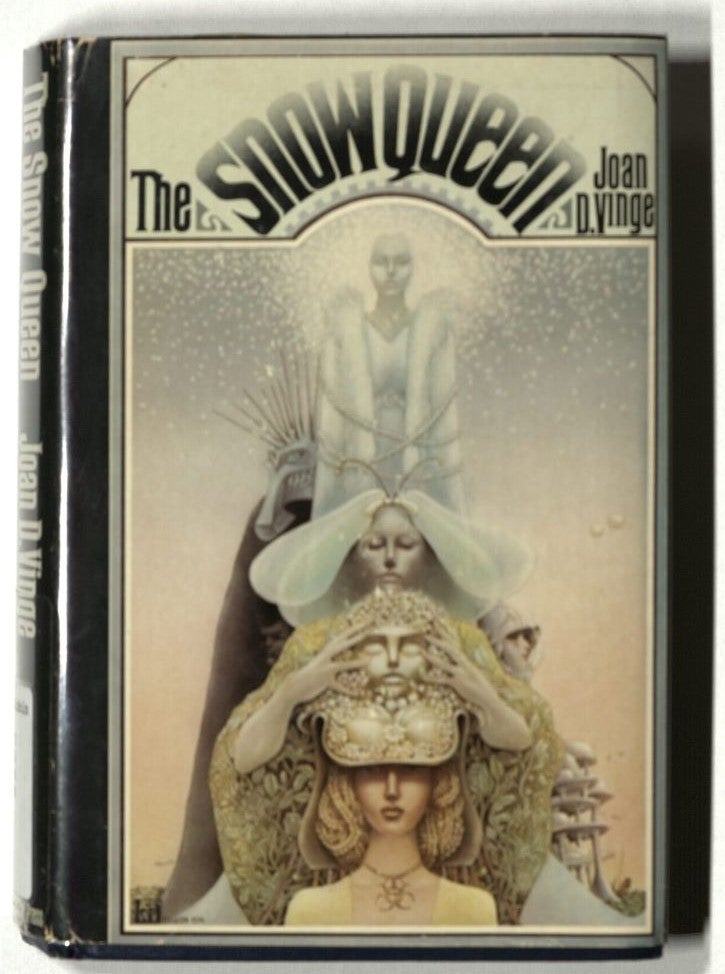Schlobin Selections #7: The Snow Queen by Joan D. Vinge

The Snow Queen by Joan D. Vinge
Over the next several weeks, we will be highlighting a select number of titles and authors from the James H. and Virginia Schlobin Literature of the Fantastic Collection. Established in 2004 by East Carolina University English Professor Roger C. Schlobin, the James H. and Virginia Schlobin Literature of the Fantastic Collection provides scholarly materials to researchers and students interested in Science Fiction and Fantasy literature. The collection consists of over 3,700 individual books, mostly primary literature in the form of novels, and collected short narratives with some additional secondary literature and scholarly criticism related to the various genres that are represented. The James H. and Virginia Schlobin Literature of the Fantastic Collection also has a related manuscripts collection which consists of nearly 5 cubic feet of materials which can be accessed online.
Title: The Snow Queen
Author: Joan D. Vinge
Illustrated by: Lea and Diane Dillon and Michael Whelan
Publisher: The Dial Press
Publication Date: 1980
Page Count: 471
Call Number: PS3572.I53 S596 1980
Originally published in 1980, Joan D. Vinge’s (1978- ) The Snow Queen is based on Hans Christian Andersen’s 1844 fairytale of the same name and is the first of four titles that make up her The Snow Queen Cycle series. Set on the fictional planet Tiamat, society has been divided into two clans, the Winters and the Summers. Each clan has control of the government for 150 years with the Winters’ Snow Queen and the Summers’ Summer Queen being recognized as the sovereign ruler during this time. At the end of the 150-year cycle, the ruling monarch is ceremoniously executed and the opposite clan ascends to power. This all takes place during a multi-day festival referred to as the Change. At the opening of Vinge’s story, the current Snow Queen Arienrhood has been secretly working to extend her rule beyond her scheduled execution by implanting clones of herself within several women from the Summer clan. Of these clones, the only one able to survive is Moon Dawntreader Summer. Moon eventually develops a romantic relationship with her cousin, a Summer named Sparks, and she also becomes a sibyl. For the Summers, sibyls are individuals who possess great influence due to their ability to answer any questions presented to them. Jealous of Moon, Sparks travels to the capital city Carbuncle where he is captured by the Snow Queen Arienrhood and becomes both the commander of her military as well as her consort.
After learning about what happened to Sparks, Moon sets off for Carbuncle despite sibyls not being permitted to enter the city. During her travels, she is abducted by smugglers and taken offworld, a trip that usually results in individuals not being permitted to return to Tiamat. Learning of Moon’s kidnapping, Arienrhood is outraged as she had planned to lure Moon to the capital to influence her to brush aside the ways and beliefs of the Summers before implanting her as the next Summer Queen, thus continuing her rule by proxy. Unable to move forward with her original scheme, Arienrhood sets into motion a plan that would kill most of the Summer population, allowing the planet to stay under the control of the Winters.
During all of this, Moon has been taken to the nearby planet Kharemough where she learns that the social issues and tension that divides the Winters and Summers are all fabricated to ensure that the political structure of the Hegemony, the remnants of the former Galactic Empire, can remain in place without opposition. Armed with this new information and determined to save Sparks, Moon returns to Tiamat to confront the Snow Queen and foils her plot of planet-wide genocide. Moon is ultimately chosen as the next Summer Queen and takes it upon herself to guide her people and the planet through the next 150 years.
Upon its initial release, Vinge’s The Snow Queen was well-received by readers and critics of the fantasy/science fiction genres. Praised for her extensive world-building that allowed her readers to be transported into the story, Vinge’s efforts were rewarded with the 1981 Hugo Award for Best Novel as well as the 1981 Locus Award for Best Novel. The Snow Queen was also nominated for the 1981 Nebula Award for Best Novel but the award ultimately went to Timescape by Gregory Benford.
Read previous entries from Schlobin Selections.
Sources:
- Aragona, Mark. “Book Review: The Snow Queen by Joan D. Vinge.” Digital Science Fiction, August 23, 2011. https://web.archive.org/web/20140113174926/http://digitalsciencefiction.com/book-review-the-snow-queen-by-joan-d-vinge/.
- Mansouri, Tia. “Judging a Book by Its Cover: The Snow Queen”. Fantasy Matters, University of Minnesota.
- “The Snow Queen Series.” TV Tropes, n.d. https://tvtropes.org/pmwiki/pmwiki.php/Literature/TheSnowQueenSeries.
